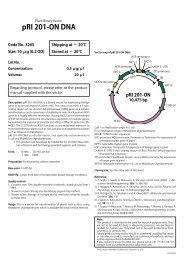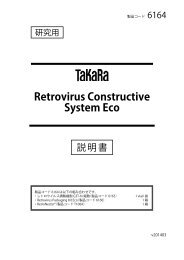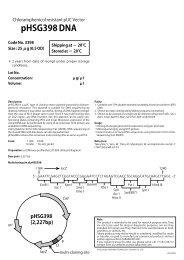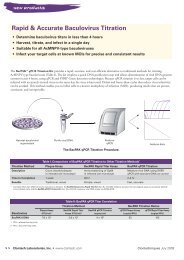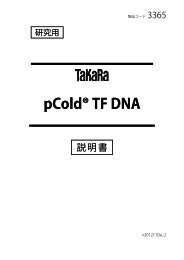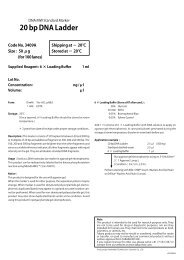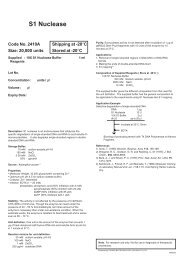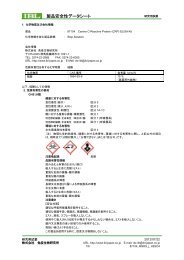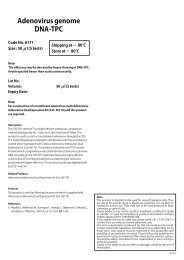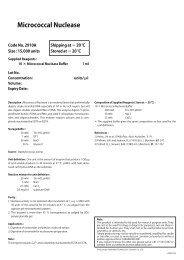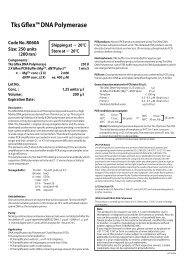Matchmaker⢠Gold Yeast Two-Hybrid System
Matchmaker⢠Gold Yeast Two-Hybrid System
Matchmaker⢠Gold Yeast Two-Hybrid System
Create successful ePaper yourself
Turn your PDF publications into a flip-book with our unique Google optimized e-Paper software.
New Products<br />
Matchmaker <strong>Gold</strong> <strong>Yeast</strong> <strong>Two</strong>-<strong>Hybrid</strong> <strong>System</strong><br />
A novel reporter system allows you to discover interactions more easily and with fewer false positives<br />
• 4 reporters & 3 promoters lead<br />
to fewer false positives<br />
• Interacting fusion proteins produce<br />
resistance to Aureobasidin A—<br />
a very potent yeast antibiotic<br />
• Antibiotic, nutritional, and<br />
blue/white selection for simple<br />
yet stringent screens<br />
GAL4 AD<br />
Prey<br />
Bait<br />
GAL Promoter<br />
GAL4 DNA-BD<br />
RNA Pol II<br />
Clontech’s Matchmaker <strong>System</strong>s are<br />
highly advanced tools for identifying<br />
and characterizing novel protein-protein<br />
interactions (PPIs). Our latest and most<br />
powerful incarnation, the Matchmaker<br />
<strong>Gold</strong> <strong>Yeast</strong> <strong>Two</strong>-<strong>Hybrid</strong> <strong>System</strong>, adds a<br />
sensitive Aureobasidin A (AbA; 1) antibiotic<br />
resistance marker to two nutritional reporters<br />
and blue/white color selection to create<br />
a four-reporter system with the easiest,<br />
most stringent yeast two-hybrid (Y2H)<br />
screening strategy available (Figure 1).<br />
Aureobasidin A effectively kills yeast, but<br />
when the AUR1-C gene is turned on by a<br />
positive interaction between GAL4-hybrid<br />
proteins, the yeast become AbA-resistant.<br />
Secondary confirmation of positive clones<br />
employs four reporters regulated by three<br />
different GAL4-reponsive promoters. This<br />
effectively eliminates false positives, and<br />
leaves you with greater numbers of genuine<br />
positives. Quality screening results<br />
like these, as well as our simple “Mate &<br />
Plate” library screening protocol, save<br />
you time and make your search for PPIs<br />
faster, easier, and more fruitful.<br />
<strong>Two</strong>-<strong>Hybrid</strong> <strong>System</strong><br />
Principles<br />
Y2H systems exploit the modular nature<br />
of eukaryotic transcription factors, which<br />
consist of a sequence-specific DNAbinding<br />
domain (DNA-BD) and an RNA<br />
Pol II-recruiting transcription activation<br />
domain (AD; 2, 3). In Matchmaker <strong>System</strong>s,<br />
a known protein of interest is fused to the<br />
DNA-BD of the yeast GAL4 transcription<br />
factor to create a “bait” protein. Interacting<br />
partner proteins, often derived from a<br />
library, are expressed as fusions to the AD<br />
of yeast GAL4, to create “prey” proteins<br />
Figure 1. <strong>Yeast</strong> two-hybrid system design. Library-derived, transcription-activating<br />
prey fusion proteins that interact with the DNA-binding bait fusion protein activate<br />
the expression of reporter genes.<br />
Promoters<br />
M1<br />
M1<br />
G1<br />
G2<br />
Figure 2. Four reporters give Matchmaker <strong>Gold</strong> its high stringency. Interacting bait and<br />
prey fusion proteins drive the expression of four different reporters from three different<br />
GAL4-responsive promoters (M1, G1, and G2), which are stably integrated in the genome<br />
of the reporter strain, Y2H<strong>Gold</strong>. Aureobasidin A (AbA) resistance and the two auxotrophic<br />
reporters for histidine and adenine biosynthesis confer growth selection in the presence<br />
of AbA and on histidine- and adenine-deficient media, while the α-galactosidase reporter<br />
produces blue colonies in the presence of X-alpha-Gal.<br />
(Figure 1). When pairs of interacting bait<br />
and prey fusion proteins are coexpressed<br />
in a yeast cell, GAL4 function is restored<br />
and the interacting fusion proteins are able to<br />
activate transcription of the reporter genes.<br />
In Matchmaker <strong>Gold</strong>, yeast clones that<br />
harbor interacting protein pairs can then<br />
be identified by the presence of the four<br />
reporters (Figure 2). In library screens, the<br />
plasmids containing the coding sequences<br />
for the library-derived prey proteins can be<br />
rescued from the surviving yeast clones, and<br />
subjected to further analysis and sequencing.<br />
5'<br />
Reporter Genes<br />
Aureobasidin A Resistance<br />
α-Galactosidase<br />
Histidine Biosynthesis<br />
Adenine Biosynthesis<br />
mRNA<br />
Aureobasidin A<br />
Selection Eliminates<br />
Background<br />
Matchmaker <strong>Gold</strong> <strong>System</strong>s are unique<br />
because they use the AUR1-C gene as a novel<br />
reporter that confers resistance to AbA,<br />
a potent antibiotic toxic to S. cerevisiae.<br />
Resistance to this highly stable antifungal<br />
depsipeptide (see page 9) allows straightforward<br />
Y2H library screening to be achieved<br />
without the optimization required when<br />
using nutritional selection alone. HIS3-<br />
Clontech Laboratories, Inc. • www.clontech.com Clontechniques January 2009<br />
7
New Products<br />
Matchmaker <strong>Gold</strong> <strong>Yeast</strong> <strong>Two</strong>-<strong>Hybrid</strong> <strong>System</strong>…continued<br />
Mate & Plate<br />
Library Vial<br />
(Y187)<br />
+<br />
Bait<br />
Culture<br />
(Y2H<strong>Gold</strong>)<br />
Combine overnight<br />
and plate<br />
Figure 3. The Mate & Plate Protocol.<br />
To screen a Matchmaker Mate & Plate<br />
Library, an aliquot of the library in the Y187<br />
strain (MATα) is simply mixed with a baitexpressing<br />
culture of the Y2H<strong>Gold</strong> strain<br />
(MATa). The mated strains are cultured<br />
overnight and plated on selective agar<br />
medium (e.g. -Leu/-Trp + AbA + X-alpha-Gal).<br />
Mate & Plate<br />
Libraries & Screening<br />
Another major advantage of Matchmaker<br />
<strong>Gold</strong> is that we’ve replaced cumbersome<br />
library-scale yeast transformation with an<br />
easy “Mate & Plate” strategy that consists<br />
of combining the two haploid yeast strains<br />
that independently express the bait and<br />
prey fusion proteins (Figure 3). Y2H<strong>Gold</strong><br />
is a MATa strain which harbors the four<br />
integrated reporter genes and is transformed<br />
with a pGBKT7 plasmid to express<br />
the bait protein. The library “prey” strain,<br />
Y187, is a MATα strain and the ideal<br />
mating partner for Y2H<strong>Gold</strong>.<br />
Clontech offers a variety of pretransformed<br />
Mate and Plate Libraries in Y187 (see<br />
pages 6–7). Alternatively, users can either<br />
create and transform their own library using<br />
the Make Your Own “Mate & Plate”<br />
Library <strong>System</strong> (see pages 4–5), or<br />
transform a plasmid expressing a userselected<br />
prey fusion protein. Combining<br />
the Y2H<strong>Gold</strong> and Y187 strains for mating<br />
is very easy and results in diploid yeast that<br />
coexpress the desired combinations of<br />
the bait and prey proteins.<br />
High Numbers of<br />
Confirmed Positive<br />
Clones<br />
Due to the strong selective power of AbA<br />
resistance, first-round, low stringency<br />
screening selects only for blue, AbA-resistant<br />
colonies. <strong>Two</strong>-thirds of these putative<br />
positive clones are later confirmed by high<br />
stringency screening, which selects for all<br />
four reporters. As a result, we now recommend<br />
low stringency screening to generate a large<br />
pool of colonies, followed by high stringency<br />
verification. This leads to more genuine<br />
positives and fewer false positives (Figure 4).<br />
based selection can produce high numbers<br />
of background colonies in primary<br />
screens, whereas AbA very effectively kills<br />
yeast cells not expressing the AUR1-C<br />
reporter. As a result, even low stringency<br />
primary screens using AbA are quite<br />
definitive and produce a high percentage<br />
of genuinely positive clones, without<br />
the interference of background colonies.<br />
Four Reporters<br />
Identify Genuine<br />
Positives<br />
The stringency of Matchmaker <strong>Gold</strong> lies<br />
in the use of four selective reporter genes:<br />
AUR1-C, HIS3, ADE2, and MEL1 (αgalactosidase),<br />
whose expression is driven<br />
by 3 different GAL4-binding promoters<br />
(Figure 2). All of the reporter genes are<br />
stably integrated into the genome of the<br />
Y2H<strong>Gold</strong> reporter strain. This strategic<br />
combination of four reporters virtually<br />
eliminates false positives, especially those<br />
arising from spurious GAL4 promoterbinding<br />
prey proteins, which might bind<br />
one promoter sequence but not all three.<br />
A<br />
Low stringency<br />
Figure 4. Secondary Matchmaker <strong>Gold</strong> screening confirms high numbers of positive clones.<br />
A Y2H<strong>Gold</strong> bait containing the POU domain from the mouse Oct4 transcription factor<br />
(BD-POU mOct4<br />
) was used to screen the Mate & Plate Universal Mouse (Normalized) Library<br />
for Oct4-binding proteins. 32 colonies from a low stringency primary screen (DDO + AbA,<br />
60 ng/ml + X-alpha-Gal) were selected and replated/patched onto fresh low stringency<br />
medium (Panel A) and onto high stringency medium (QDO + AbA, 60 ng/ml + X-alpha-Gal)<br />
(Panel B) to confirm the expression of all four Matchmaker <strong>Gold</strong> reporters. Of the 32 originally<br />
selected colonies, 25 were confirmed positive for the 4 reporters. DDO = Double dropout<br />
medium: SD/–Leu/–Trp. QDO = Quadruple dropout medium: SD/–Ade/–His/–Leu/–Trp.<br />
Table I: Mouse Oct4-Binding Proteins Identified in Matchmaker <strong>Gold</strong><br />
Library Screening¹<br />
Protein Function<br />
E2I/Ubc9 Small ubiquitin-related modifier (SUMO) enzyme involved in sumoylation<br />
of Oct4; regulates Oct4 stability<br />
PIAS1 An E3 ligase protein inhibitor of activated STAT1; a potent inhibitor<br />
of Oct4-mediated transcriptional activation<br />
PSMB5 Proteasome beta5 subunit; may mediate the interaction of Oct4 with<br />
proteasomes, which regulate cellular processes through protein degradation.<br />
1 Mate & Plate Library - Universal Mouse (Normalized).<br />
B<br />
High stringency<br />
8<br />
Clontech Laboratories, Inc. • www.clontech.com Clontechniques January 2009
New Products<br />
Matchmaker <strong>Gold</strong> <strong>Yeast</strong> <strong>Two</strong>-<strong>Hybrid</strong> <strong>System</strong>…continued<br />
Number of colonies (normalized)<br />
120<br />
100<br />
80<br />
60<br />
40<br />
Aureobasidin A<br />
Resistance is Highly<br />
Selective<br />
To demonstrate the highly selective properties<br />
of AbA resistance, AbA was titrated<br />
against three diploid Y2H<strong>Gold</strong> clones that<br />
each expressed different bait/prey protein<br />
pairs (Figure 5). A negative control strain<br />
that coexpressed a non-interacting protein<br />
pair (BD-POU mOct4<br />
bait and an unmodified<br />
GAL4 AD protein, AD-null), was completely<br />
unable to grow in the presence of AbA<br />
concentrations above 40 ng/ml. When the<br />
BD-POU mOct4<br />
bait was paired with a putatively<br />
interacting prey protein (AD-E2I),<br />
colonies were able to grow in the presence<br />
of 70–100 ng/ml AbA. This result suggests<br />
that these proteins interact well enough<br />
to activate AUR1-C expression and allow<br />
colony growth on AbA medium. In a<br />
positive control, the strongly interacting<br />
protein pair of DNA-BD-p53 and AD-SV40<br />
large T antigen enabled the vast majority<br />
of colonies to grow in the presence of<br />
100 ng/ml AbA—the highest concentration<br />
tested, and indicated a very high level<br />
of AUR1-C expression.<br />
Strong<br />
Moderate<br />
20<br />
Null<br />
0<br />
0 20 40<br />
60 80<br />
DDO + AbA (ng/ml)<br />
Figure 5. Titration of Aureobasidin A for three different Matchmaker protein pairs. Y2H<strong>Gold</strong><br />
yeast clones coexpressing one of three bait/prey fusion protein pairs: a negative control<br />
(BD-POU mOct4<br />
+ AD-null); a pair of putative interactors (BD-POU mOct4<br />
+ AD-E2I); or a positive<br />
control (BD-p53 + AD-T-Ag), were grown on DDO agar (SD/-Trp/-Leu) in the presence of<br />
increasing concentrations of AbA. The relative ability of each strain to grow in the presence<br />
of AbA reflects the strength of the interactions between the bait and prey proteins. Libraries<br />
are usually screened in the presence of AbA at 60 ng/ml, which demonstrates definitive selection<br />
for interacting hybrids. POU mOct4<br />
= POU domain from the mouse transcription factor, Oct4.<br />
100<br />
BD-POU mOct4 + AD-null<br />
BD-POU mOct4 + AD-E21<br />
BD-p53 + AD-T-Ag<br />
Superior to<br />
Nutritional Selection<br />
Alone<br />
The use of auxotrophic reporters alone for<br />
Y2H screening often requires optimization<br />
steps, especially in the case of HIS3-based<br />
selection, to ensure that the growth conditions<br />
are sufficiently selective. The leakiness<br />
of HIS3 selection necessitates the use of<br />
3-AT (a competitive inhibitor of the His3<br />
protein), which must be titrated and included<br />
in the growth medium to suppress the<br />
growth of background colonies. With AbA<br />
selection and the two nutritional markers<br />
of Matchmaker <strong>Gold</strong>, growth selection<br />
is sufficiently stringent so as to make<br />
the use of 3-AT unnecessary.<br />
With the Matchmaker <strong>Gold</strong> <strong>System</strong><br />
and a wide selection of tissue-specific,<br />
normalized, and universal Mate & Plate<br />
Libraries, Clontech offers the most convenient<br />
and advanced Y2H screening tools<br />
available. You can even construct your<br />
own library with the Make Your Own<br />
“Mate & Plate” Library <strong>System</strong>. Library<br />
screens can now be accomplished in less<br />
time and with greater confidence than<br />
ever before.<br />
Product Size Cat. No.<br />
Matchmaker <strong>Gold</strong> <strong>Yeast</strong> <strong>Two</strong>-<strong>Hybrid</strong> <strong>System</strong><br />
each 630489<br />
Mate & Plate Library – Universal Mouse (Normalized)<br />
2 x 1 ml 630482<br />
Make Your Own “Mate & Plate” Library <strong>System</strong><br />
5 rxns 630490<br />
<strong>Yeast</strong> Media Set 2<br />
each 630494<br />
<strong>Yeast</strong> Media Set 2 Plus<br />
each 630495<br />
Aureobasidin A<br />
1 mg 630466<br />
X-alpha-Gal 100 mg 630462<br />
250 mg 630463<br />
Matchmaker <strong>Gold</strong> <strong>Yeast</strong> <strong>Two</strong>-<strong>Hybrid</strong> <strong>System</strong><br />
Components<br />
• pGBKT7 DNA-BD Cloning Vector<br />
• pGADT7 AD Cloning Vector<br />
• pGBKT7-53 Control Vector<br />
• pGBKT7-Lam Control Vector<br />
• pGADT7-T Control Vector<br />
• Y2H<strong>Gold</strong> <strong>Yeast</strong> Strain<br />
• Y187 <strong>Yeast</strong> Strain<br />
• YPDA Broth<br />
• YPDA with Agar<br />
• SD/-Trp with Agar<br />
• SD/-Leu with Agar<br />
• <strong>Yeast</strong>maker <strong>Yeast</strong> Transformation <strong>System</strong> 2<br />
<strong>Yeast</strong> Media Set 2 Components (0.5 L pouches)<br />
• YPDA Broth (2 each)<br />
• YPDA with Agar<br />
• SD/-Leu Broth<br />
• SD/-Leu with Agar<br />
• SD/-Trp Broth<br />
• SD/-Trp with Agar<br />
• SD/-Leu/-Trp with Agar (DDO; 10 each)<br />
• SD/-Ade/-His/-Leu/-Trp with Agar (QDO)<br />
<strong>Yeast</strong> Media Set 2 Plus Components<br />
• <strong>Yeast</strong> Media Set 2<br />
• Aureobasidin A (1 mg)<br />
• X-alpha-Gal (250 mg)<br />
Notice to Purchaser<br />
Please see the Aureobasidin Drug, Aureobasidin<br />
Resistance Gene, Matchmaker <strong>Two</strong>-<strong>Hybrid</strong><br />
<strong>System</strong>, and Reverse <strong>Two</strong>-<strong>Hybrid</strong> Technology<br />
licensing statements on page 40.<br />
References<br />
1. Takesako, K. et al. (1991) J. Antibiot.<br />
44(9):919–924.<br />
2. Fields, S & Song, O. (1989) Nature<br />
340(6230):245–246.<br />
3. Chien, C. T. et al. (1991) Proc. Nat. Acad. Sci. USA<br />
88(21):9578–9582.<br />
NEW!<br />
NEW!<br />
NEW!<br />
NEW!<br />
NEW!<br />
NEW!<br />
Clontech Laboratories, Inc. • www.clontech.com Clontechniques January 2009<br />
9




